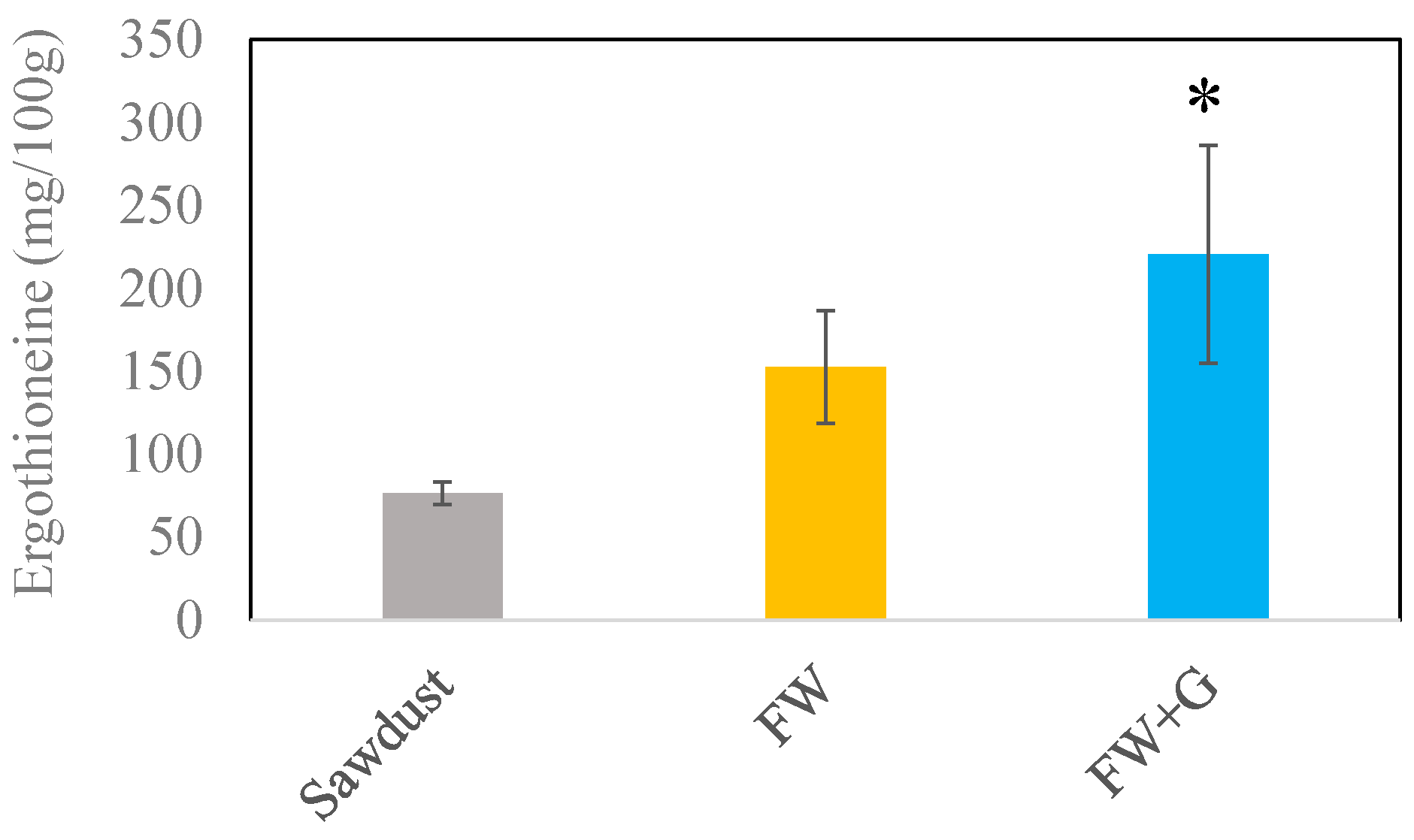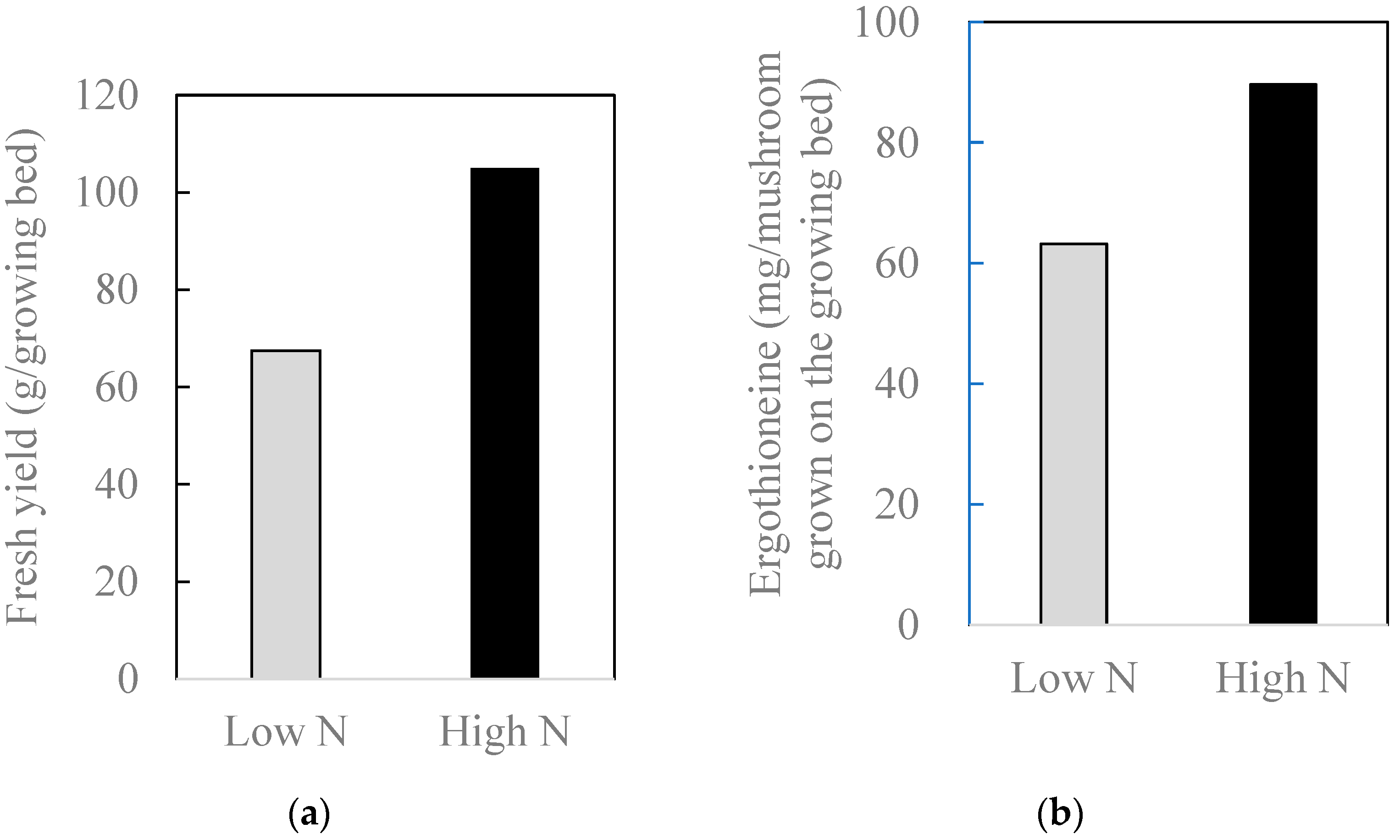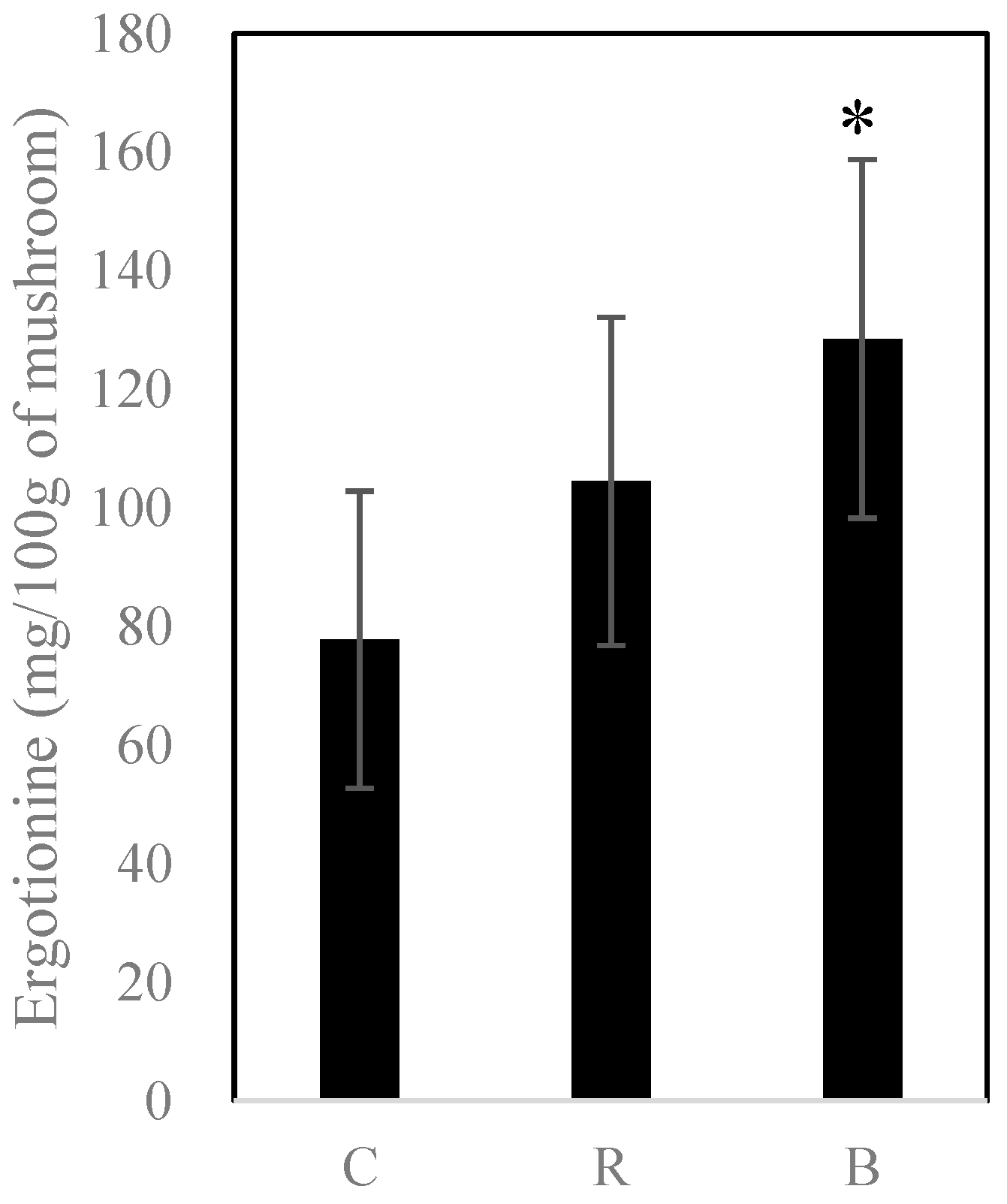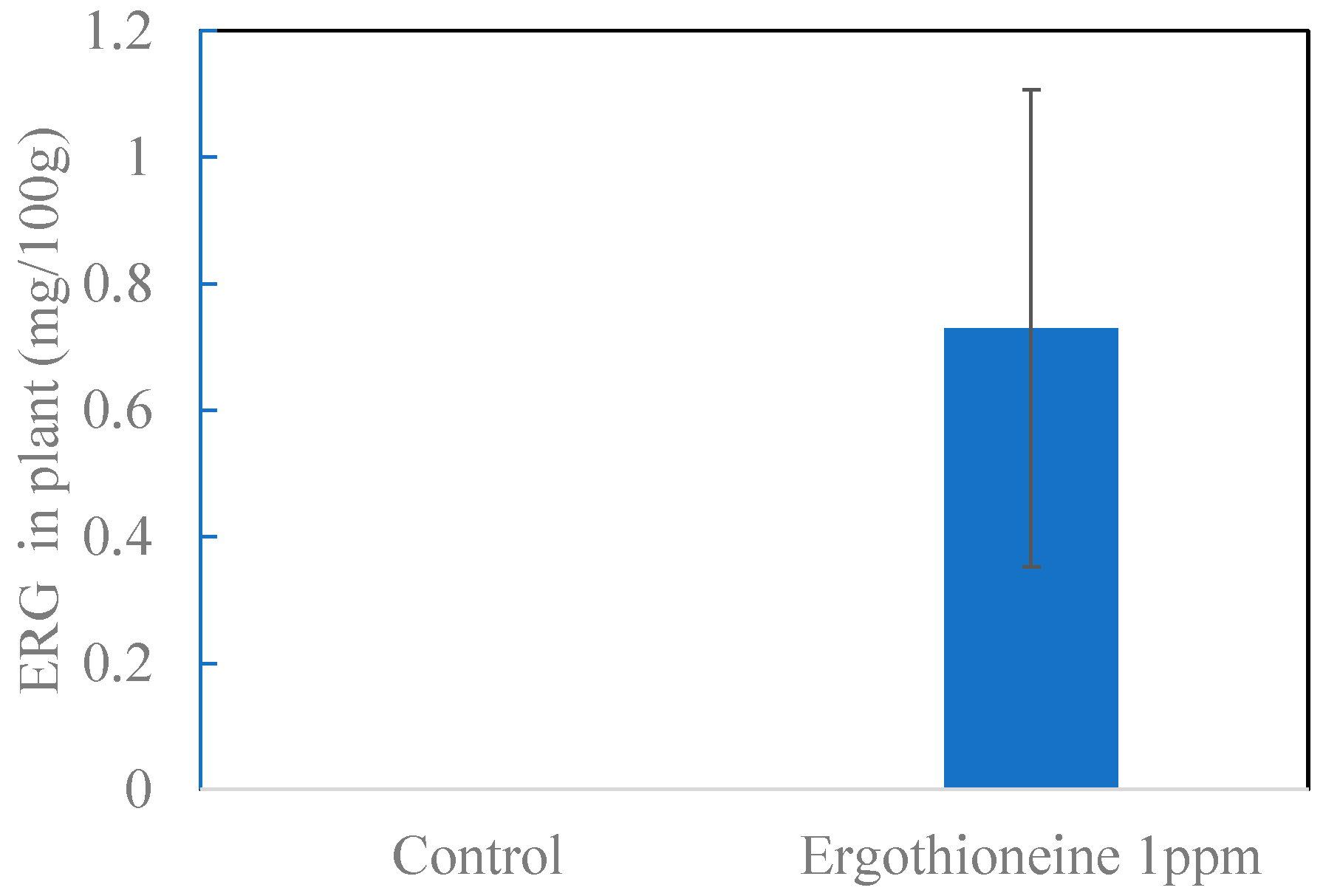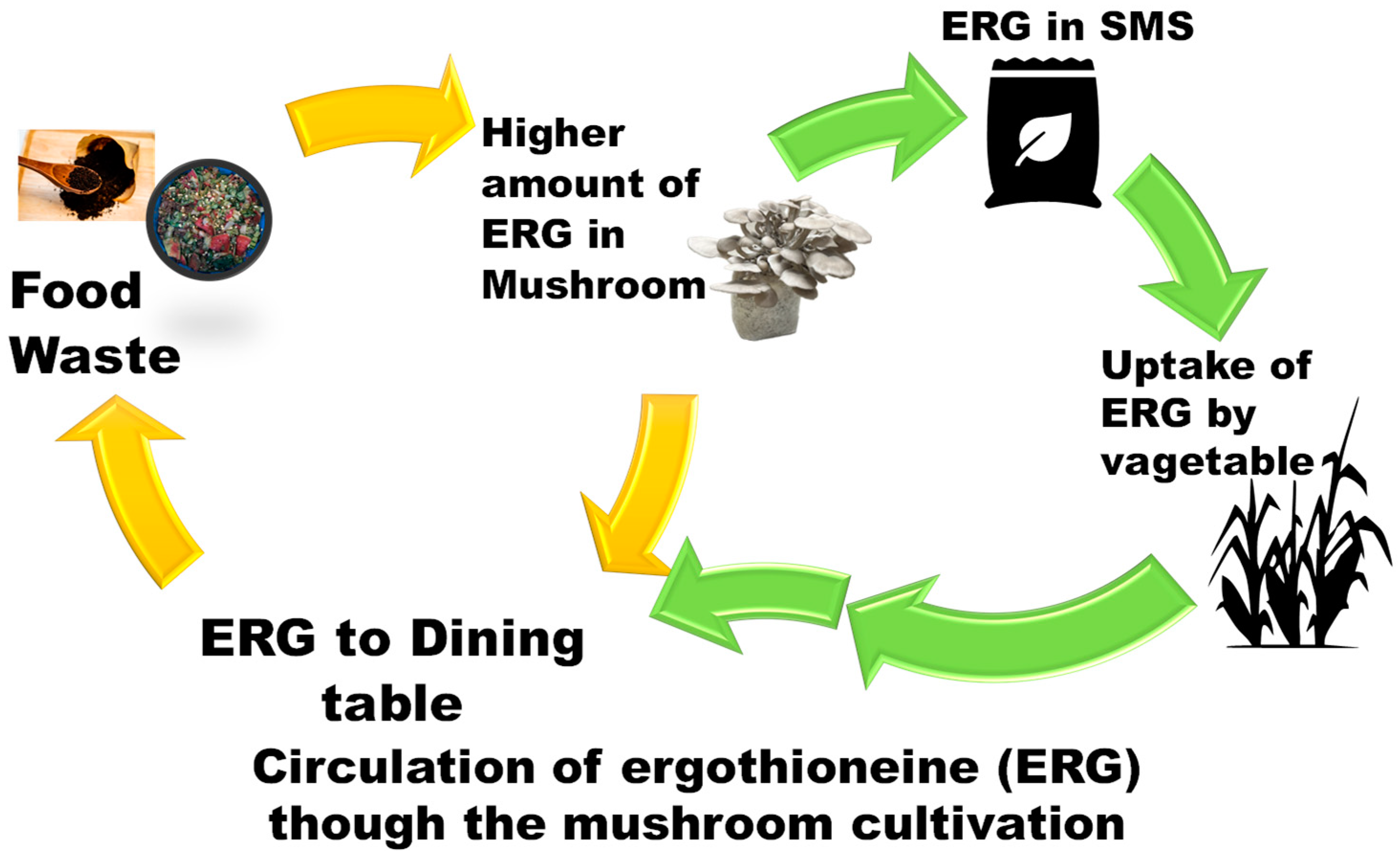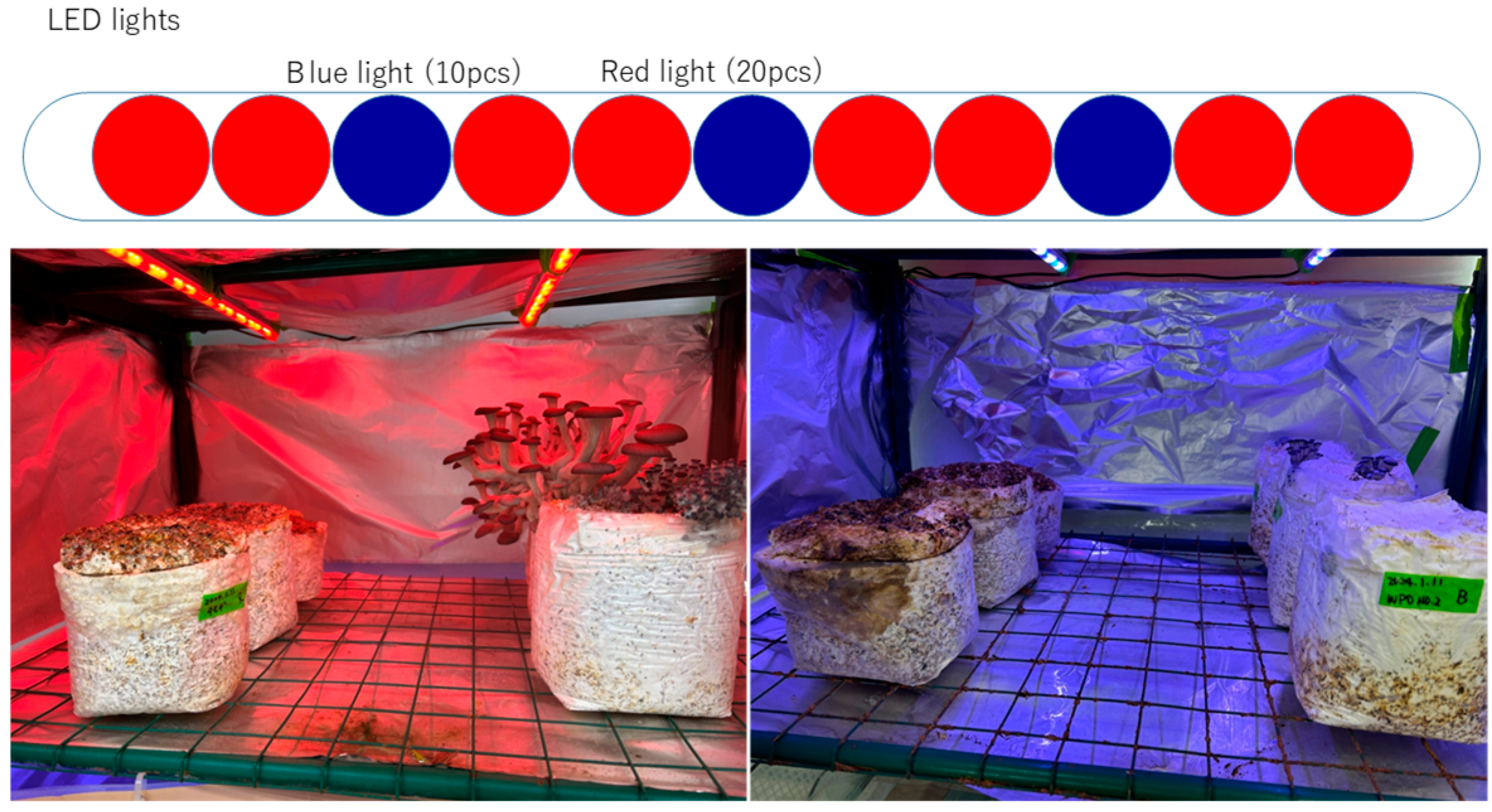1. Introduction
Mushrooms have long been an essential part of the diet of many cultures, including those in Asia, Europe, and the United States. Between 1990 and 2020, global mushroom production increased 13.8-fold to 42.8 million tons [
1]. According to data from the Food and Agriculture Organization of the United Nations (FAO), global mushroom production has been increasing year by year, reaching 48.34 million tons in 2022, up 9.4% from the previous year. By country, China accounts for 94.0% of the total, followed by Japan and the United States [
2].
Mushrooms are usually produced in mushroom beds using sawdust and wood chips as the main raw materials, with rice bran and wheat bran added to supplement the missing nutrients. The advantage of mushroom bed cultivation is that it may be grown year-round and produced in large quantities. However, more than 100 million tons of spent mushroom substrate (SMS) are produced annually, putting a heavy burden on the environment [
3]. To minimize the waste generated by the mushroom industry, research is being conducted on composting, converting waste into fuel or feed, and recycling it as a mushroom cultivation medium [
4]. In response, we developed a mushroom bed medium that can grow mushrooms using food waste, including food loss, as the primary source material. Cultivating mushrooms using the developed mushroom bed medium not only yields an abundant harvest but also eliminates the need for composting and allows the used mushroom bed to be restored to agricultural land [
5].
Mushrooms are important ingredients in ethnopharmacology and traditional medicine because of their diverse health-promoting properties, including antioxidant, anti-inflammatory, anticancer, antibacterial, anti-cholesterol, prebiotic, gene-protecting, and immunomodulatory properties [
6]. Mushrooms are commonly included in daily meals and used in a variety of dishes, not only for their delicious flavor but also for their protein, crude fiber, vitamins, carbohydrates, and minerals [
7]. Edible mushrooms contain bioactive compounds that promote health and are used for a wide range of medicinal purposes worldwide. Ergothioneine (ERG), a water-soluble, thiol-containing, antioxidant amino acid, is a distinct bioactive molecule found in mushrooms. It is a stable antioxidant that does not degrade even at high temperatures or pH. ERG is not synthesized by plants or animals (including humans). It is primarily derived from edible mushrooms such as
Agaricus bisporus,
Lentinula edodes,
Pleurotus ostreatus, and
Grifola frondosa [
8]. ERG is a rare betaine of 2-thiohistidine that has strong antioxidant properties. Various microorganisms synthesize it, particularly fungi (including mushroom fruiting bodies) and actinomycetes. Therefore, plants and animals need to take in ERG from the soil or their diet, respectively. Mushrooms are rich in ERG, which has several health benefits. Increasing the ERG content of mushrooms will not only increase their value as a health food but will also help to brand mushroom production in Japan. However, to the best of our knowledge, no research has been undertaken on this subject. It is also unclear how plants absorb ERG. Therefore, the goal of this study was to develop a mushroom cultivation medium out of food waste, including food loss, that contains high concentrations of ERG. We also discuss the dynamics of ERG in spent mushroom substrates that were released into farmland following the mushroom harvest.
3. Discussion
Since the Food Recycling Law came into effect, local governments in Japan have been working to recycle food waste, but large amounts of food waste continue to be generated by businesses and households, with the annual amount of food waste reaching 23.72 million tons in 2020 [
9]. Households generate approximately 31.5% (7.48 million tons) of food waste, and according to Ministry of the Environment estimates in 2020, 560,000 tons of household food waste are used for fertilizer and methane production, while the remaining 6.92 million tons are incinerated or landfilled, implying that approximately 7% of the total is reused [
9]. Most food waste is incinerated, which is costly and energy-intensive, and a significant percentage of food is lost during distribution. The ultimate purpose of this research was to establish a local food production system based on mushroom cultivation using food waste, as well as to stimulate small-scale circulation in each region and area. To promote decentralized recycling in a sustainable manner, we focused on ERG, which is abundant in oyster mushrooms. We believe that by increasing the value of mushrooms as a healthy food ingredient, we can create new demand and supply for mushrooms while also encouraging food waste recycling from households in each region (decentralized recycling).
In this study, we improved the composition of the culture medium to enable the cultivation of mushrooms with a high ERG content. Next, we investigated a mushroom cultivation technique using LED irradiation that allows for a high ERG content. We also established an agricultural utilization technology for a waste medium with a high ERG content and, for the first time, explored ERG absorption from leafy vegetables. The mushrooms grown on the culture medium made primarily from food waste contained more ERG than commercially available oyster mushrooms grown primarily on sawdust; when food waste was mixed with household kitchen scraps, the ERG content was higher than when food waste was used alone. We believe that the nitrogen derived from animal protein content of the medium plays a crucial role in the production of ERG via a synthetic pathway that starts with the binding of cysteine to histidine. Increasing the amount of nitrogen derived from animal protein in the medium raised the ERG concentration in the mushrooms. As a result, household food waste in the medium is not limited to vegetable waste; animal derived waste can also be used.
Both red and blue light are necessary for plant growth. Chlorophyll absorbs red light well, while blue light has a substantial effect on plants [
10], such as for opening and closing stomata [
11]. In recent years, research on mushrooms has focused on light, similar to research on plants. For example, it has been found that exposing shiitake mushrooms to blue LEDs activates glycolysis and the pentose phosphate pathway [
12]. However, there is still little research testing the effect of light on mushrooms. Using a food-based fungal bed medium, it was found that irradiating fruiting bodies with blue (450 nm) or red (660 nm) LED lights during development increased their ERG concentration. They found that ERG content was higher when irradiated with blue light than with red light. Kim et al. [
13] also showed that blue light was effective in decreasing the cultivation period and increasing the ERG content of shiitake mushrooms, which is consistent with the findings of this study.
ERG can also be detected in waste mushroom substrates after harvesting mushrooms with a high ERG content. In agriculture, spent mushroom substrates containing ERG may be used to grow vegetables, allowing ERG to be consumed not only from mushrooms but also from vegetables in daily meals. In this study, ERG was added to a hydroponic solution during hydroponic cultivation at a final concentration of 1 ppm, and the transfer of ERG to the plant body was investigated. ERG was detected in the bodies of komatsuna plants one week after cultivation, with a transfer rate of approximately 1.8% (
Figure 4). It was found that ERG was transferred to the plant body; however, this test was limited to young seedlings. In the future, we need to grow vegetables to a shipping size and verify the ERG transfer rate in mushrooms. We also wish to confirm the ERG content of vegetables when waste mushroom bed media are used in agriculture.
In recent years, a growing number of studies have shown that ERG has a beneficial effect on human health. There is a positive correlation between ERG intake and lifespan, and it has been shown to have anti-aging properties, such as the inhibition of UV-induced skin damage [
14]. It has been reported that the dietary compound ERG is an important nutrient for the human body, particularly for maintaining normal brain function, and that low levels of ERG in the body increase the risk of neurodegenerative diseases (cognitive impairment, dementia, Parkinson’s disease) as well as other age-related diseases (frailty, cardiovascular disease, eye diseases, etc.) [
15]. Watanabe et al. [
16] found that taking a supplement containing 5 mg of ERG daily for 12 weeks improved verbal memory and simple attention in cognitive function measures. In this study, instead of using sawdust as the major material, food waste, which included food leftovers and kitchen food waste, was used for bed cultivation. Furthermore, it was discovered that adding food waste to the culture bed increased ERG content, and mushrooms with a high ERG content can be cultivated by adding nitrogen-rich materials(
Figure 5).
4. Materials and Methods
4.1. Culture of Spawn
Pleurotus ostreatus was cultured on potato dextrose agar (PDA) (Oxoid CMO 139; Oxoid Ltd., Basingstoke, UK) plates for spawn production. Sterilized PDA medium was added to sterilized Petri dishes (15 mL each) and allowed to solidify. Inoculation was accomplished by transferring a 5 mm disc of the mycelial mat from the periphery of a 10-day incubation culture. Plates were incubated at 25 ± 1 °C. Observations of colony diameter were made when maximal growth was achieved on the medium selected for transfer to the mother spawn substrates, as described by Barua et al. [
5]. In this study, substrate no. T-2 was used to prepare mushroom cultivation substrates [
5].
Furthermore, by separating the food waste into plant- and animal-derived kitchen food waste and adjusting the mixing ratio, mushrooms were grown in T-2 medium at varying carbon/nitrogen ratios. The base food waste is coffee grounds and barley tea grounds (FW) generated by beverage manufacturers, mixed with dried food waste (FW + G) generated by households collected by laboratory staff. Additionally, in an experiment where nitrogen content was varied, food waste containing animal protein was collected from domestic kitchens and processed separately to create food waste with different carbon and nitrogen contents. The total nitrogen was measured using the Kjeldahl method [
17] and the total carbon was measured by the Turing method [
18].
Table 1 shows the carbon/nitrogen ratios after changing the mixing ratio of plant- and animal-derived kitchen food waste. For household waste collection, a corner sink strainer was used in the kitchen sink to collect kitchen food waste generated in daily life. The collected kitchen food waste was dried using a Hitachi Household Garbage Dryer and Processor ECO-B25 (Hitachi, Ltd., Tokyo, Japan) and then stored in a plastic storage box. The composition of the kitchen food waste was not intentionally changed, and the kitchen food waste generated in daily life was treated as it was.
4.2. Mushroom Cultivation Process
As described in Barua et al. [
5], when mycelia covered the inside and other surfaces of the mushroom cultivation beds, as well as when some mushroom pinheads were observed, the top of the culture bed was cut off, a spatula or similar tool was used to carefully scrape off the area where the old spawn was inoculated, and the beds were washed with cool, clean water. The beds were moved to the cultivation chamber for three to ten days, depending on the mushroom species. The temperature was set to 20 ± 2 °C and the air humidity was set to 70–85%. The fruiting bodies were harvested after the cultivation period.
4.3. Effect of Light on the Ergothioneine Concentration
To evaluate ergothioneine concentration under different light conditions, mushrooms were grown under blue (450 nm) or red (660 nm) LEDs (
Figure 6). LED irradiation continued from the fruiting body development stage until harvest. Red, blue, and white LED treatments were replicated six, five, and five times, respectively.
4.4. Uptake of Ergothioneine by Plants
We initially added ERG to the culture solution during hydroponic cultivation to examine whether it was absorbed by the plants. Brassica rapa (Komatsuna; Japanese mustard spinach) seeds were sown in a cell tray, covered with horticultural plant growth medium, and grown until the primary leaves appeared. In an Erlenmeyer flask, 140 mL of distilled water and 140 µL of 6-10-5 chemical fertilizer (Hyponex Japan Co., Ltd., Tokyo, Japan) were mixed. The 1 ppm ERG (L-(+)-Ergothioneine (Cayman Chemical Co., Ann Arbor, MI, USA)) culture solution was created by mixing 520 µL of 250 ppm ERG solution. Five komatsuna plants from each treatment group were sandwiched between hydroponic sponges and secured to the spout of an Erlenmeyer flask. After one week of cultivation, the fresh weight was measured, and each plant was carefully washed and then sliced into small pieces. The sliced komatsuna was placed in a 50 mL tube, 50 mL of distilled water was added, and extraction was performed for 2 h. The extract (50 mL) was analyzed using HPLC.
4.5. Extraction of Ergothioneine
Harvested mushrooms were stored at −80 °C until use. ERG was extracted and analyzed in accordance with GL Science [
19]. Finely cut material (2 g) was placed in a 50 mL conical tube with 20 mL of ultrapure water, then heated at 100 °C for 1 h. Following extraction, the supernatant was separated and transferred to a new 50 mL conical tube. This procedure was repeated twice. The volume of the supernatant after each extraction was adjusted to 50 mL using methanol. A portion (1.2 mL) of this mixture was separated in a microtube and centrifuged at 15,000 rpm for 10 min, and 1 mL was transferred to a vial for HPLC analysis. A calibration curve was prepared using 5 and 10 ppm ERG as standard solutions. The concentration of ERG was analyzed using HPLC (Shimadzu Corporation, Kyoto, Japan) with an Inertsil
® PFP (4.6 × 250 mm) column (GL Sciences Inc., Tokyo, Japan). The samples were injected with a 0.05% acetic acid aqueous solution at a flow rate of 1 mL min
−1.
4.6. Statistical Analysis
Statistical analyses were performed using the IBM SPSS Statistics Base 22 (IBM, Armonk, NY, USA). The Dunnett test was used to determine significance, with an asterisk signifying p < 0.05.
